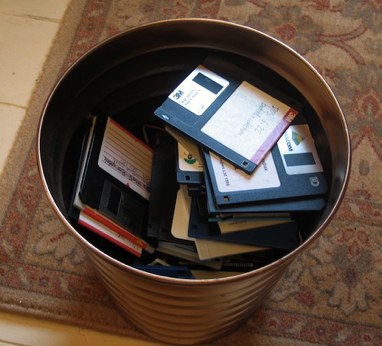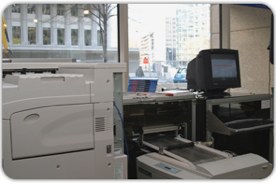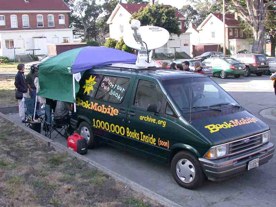This has been bothering me over the last few days:
How does Shelob manage to sting Frodo when he’s wearing the mithril vest?
This has been bothering me over the last few days:
How does Shelob manage to sting Frodo when he’s wearing the mithril vest?
The Mac’s Spotlight feature is great, but has many limitations. I love it, but I’m also frequently frustated by it.
MoRU is an alternative and much more powerful front-end to the Spotlight engine. The web page gives a good list of the features.
I really like the look of this. There’s a free trial, and it’s only $10.
On Sunday I threw out the old Gateway 66Mhz Pentium machine on which I wrote my PhD thesis many years ago. It still worked, but the inability to boot from its CD drive was becoming a bit limiting! And its two hard disks had just under 2G of capacity between them.

Today I threw out my floppy disks, realising that I no longer had any machine capable of reading them.
I’m pretty apalling at finding and choosing Christmas presents for others, and hence dislike the whole process intensely, so the streamlined nature of online shopping is a real boon, and almost all of our gift-purchasing this year was done via the web. I did have to make one phone call, but I certainly didn’t have to go into any bricks-and-mortar shops!
Not that it would have really been an option – the things I wanted to buy were definitely from the ‘Long Tail‘ and I couldn’t have found any of them in the centre of Cambridge.
Of course, this only works if you don’t adopt my usual practice of waiting until Christmas Eve. Amazon can do some wonderful things, but they can’t deliver as quickly as I can cycle in and out of the town centre.
 But perhaps that will change. Perhaps in future you’ll be able to buy books from your local Barnes and Noble even if they don’t have them on the shelves when you leave home…
But perhaps that will change. Perhaps in future you’ll be able to buy books from your local Barnes and Noble even if they don’t have them on the shelves when you leave home…
On Demand Books is developing the Espresso printing machine – described in this article as ‘an ATM for books’.
The machine can print, align, mill, glue and bind two books simultaneously in less than seven minutes, including full-color laminated covers.
(Thanks to Claes-Frederik Mannby for the link. There’s also more information here.)
 I have here a book that Brewster Kahle gave me, printed on-demand when I visited the Internet Archive a while back. Have a listen to some of his inspiring and entertaining talks, this one, for example, for a different spin on the topic – his motivation is to provide universal access to all human knowledge, and mobile on-demand printing is a part of this.
I have here a book that Brewster Kahle gave me, printed on-demand when I visited the Internet Archive a while back. Have a listen to some of his inspiring and entertaining talks, this one, for example, for a different spin on the topic – his motivation is to provide universal access to all human knowledge, and mobile on-demand printing is a part of this.
But on a larger commercial front, I predict that in the future the boundaries between print & copy outfits like Kinko’s, and bookshops like Borders, will blur dramatically, because the traditional publishing process is inefficient and slow, and, in particular, doesn’t cater for the Long Tail at all well.
One of the books I ordered this Christmas, for example, was Carl Benn’s Historic Fort York, published by a small Toronto-based press. Think about the logistics of getting it from the author’s word-processor in Canada to me here in Cambridge, even after he had gone through the typically tortuous process of getting it accepted by a publisher. Start with the publisher’s decisions about how large a print run made sense, and how much warehouse space would be taken up by as-yet-unpurchased copies sitting in various places around the world. Think about the packaging, the customs processes, the fuel involved in shipping it around the world. Even the weight in the postman’s bag as he brought it to my door.
And compare that entire process with the purely-digital alternative of downloading a PDF.
But as long as we continue to appreciate the aesthetics of reading things on paper, we will always want printing services which are faster, cheaper and higher-quality than we can have at home. And developments like the Espresso machine will be a godsend to a society which values ever more immediate gratification, and, of course, to husbands too disorganised or busy to buy their Christams presents on time.
Barnes & Noble, and Borders, and Waterstones, if they are worried about their rather uncertain future, might do well, I think, to invest heavily in on-demand printing.
At this time of year, as we know, angels are bending near the earth to touch their harps of gold.
John Naughton is posting links to an amazing interpretation of Pachelbel’s Canon on the electric guitar.
And I’m reposting a link to Jake Shimabukuro, who is bending near the earth in Central Park to touch his ukulele of gold. This piece transformed my view of the ukulele (which, I readily admit, wasn’t very well-developed beforehand!). (Update – that link is now dead. Try here.)
May you all have a musical, happy and peaceful Christmas!
Quentin
Rui Carmo says his iPod Shuffle has been my faithful companion at work for many months now (it is the only way to survive the incredible waste of productivity and endless entropy brought on by the “open space office” concept).
I think I’m generally less productive when listening to music while I work – it’s probably part of getting old – but it’s less of a negative impact than being in an open-plan office, so I do occasionally retreat into headphones if I find myself in that environment.
Rui writes about how he uses a BluEye device to switch between his iPod and incoming phone calls. Quite neat.
But I can’t help feeling that there’s scope for somebody to make a killing building more officially-office-oriented products here. If you’re blessed with an employer who’s bought into the open plan idea, then you’ll know some of the main problems:
and so forth.
The best environment I ever worked in had offices of, typically, between one and three people, and a convention that office doors would normally be open unless you didn’t want to be disturbed. We wandered freely in and out of each others’ offices and scribbled on each others’ whiteboards. Glass windows in the doors let you judge how disturbable somebody was if their door was closed.
Don’t get me wrong – I know there are some environments where the open-plan model works, but I think they are few and far between, especially if your employees are knowledge-based workers and particularly if they are programmers. Often senior management will talk about the supposed productivity improvements for everyone else but mysteriously need offices for themselves!
No, there’s usually a simpler underlying explanation. Sometimes it’s that the management don’t trust employees to be sufficiently self-motivated. But in general it’s pure economics: the cost of providing individual or small-group offices is fairly high and very obvious, while the loss of productivity from not having them is much less tangible. Many employers feel they simply can’t afford the infrastructure.
So there must be a big market for technological solutions to this problem – systems which give you the impression of a real office without isolating you too much from your colleagues. VNC-like systems in meeting rooms which let you get at your normal computing world when you’ve had to leave it for some reason. Ways of telling your co-workers that you really don’t want to be disturbed right now…
There’s a big commercial opportunity here for somebody, surely?
There was some good stuff in Mohammad Yunus’s Nobel Lecture. I’ve posted a short extract on the Ndiyo Blog.
Rose had a haircut yesterday. She also had her eyes checked. They took about the same amount of time, but the haircut cost more than the eye test.
Which probably means that anyone contemplating a career as an opthalmic optician should seriously consider the alternative of women’s hairdressing…
A couple of months ago I wrote about our gradual shift towards locally-produced organic food. Lest we become too smug, though, the Economist has a special report this week which points out that things are never as straightforward as they seem.
The first topic is organic food. “Not everyone agrees that organic farming is better for the environment”, we are told. Norman Borlaug, the father of the “green revolution” and winner of the Nobel peace prize is an outspoken advocate of the use of synthetic fertilisers to increase crop yields:
He claims the idea that organic farming is better for the environment is “ridiculous” because organic farming produces lower yields and therefore requires more land under cultivation to produce the same amount of food. Thanks to synthetic fertilisers, Mr Borlaug points out, global cereal production tripled between 1950 and 2000, but the amount of land used increased by only 10%. Using traditional techniques such as crop rotation, compost and manure to supply the soil with nitrogen and other minerals would have required a tripling of the area under cultivation. The more intensively you farm, Mr Borlaug contends, the more room you have left for rainforest.
In most areas it’s perhaps a little facile to suggest that there’s a simple swap of rainforest for organic farming, and one could argue that it might otherwise have been swapped for worse things, but it is a point worth considering.
Still, maybe we should focus more on Fairtrade produce?
Fairtrade farmers receive a minimum of $1.26 per pound for their coffee, or $0.05 above the market price if it exceeds that floor. This premium is passed back to the producers to spend on development programmes … Who could object to that?
Economists, for a start. The standard economic argument against Fairtrade goes like this: the low price of commodities such as coffee is due to overproduction, and ought to be a signal to producers to switch to growing other crops. Paying a guaranteed Fairtrade premium — in effect, a subsidy — both prevents this signal from getting through and, by raising the average price paid for coffee, encourages more producers to enter the market. This then drives down the price of non-Fairtrade coffee even further, making non-Fairtrade farmers poorer.
And while it’s true that a larger compensation does get back to the producer of Fairtrade goods,
…retailers add their own enormous mark-ups to Fairtrade products and mislead consumers into thinking that all of the premium they are paying is passed on. Mr Harford calculates that only 10% of the premium paid for Fairtrade coffee in a coffee bar trickles down to the producer. Fairtrade coffee, like the organic produce sold in supermarkets, is used by retailers as a means of identifying price-insensitive consumers who will pay more, he says.
Sigh. Still, at least there can’t be much complaint against buying from local producers?
Research carried out at Lincoln University in New Zealand found that producing dairy products, lamb, apples and onions in that country and shipping them to Britain used less energy overall than producing them in Britain. (Farming and processing in New Zealand is much less energy intensive.)
and
… a shift towards a local food system, and away from a supermarket-based food system, with its central distribution depots, lean supply chains and big, full trucks, might actually increase the number of food-vehicle miles being travelled locally, because things would move around in a larger number of smaller, less efficiently packed vehicles.
See what I mean? You can’t win.
So I’m going to start a new trend. It’s called Consumption Diversity. All methods of food production and distribution have some good effects and some bad ones. But they’re different for each method. The trick is to avoid a monoculture where all the bad bits happen to the same group of people, or damage the same part of the environment.
So we should get some of our food from organic producers to protect the bugs and the fishes, and some from non-organic to protect the rainforests. Some via Fairtrade to reduce exploitation, and some via regular market forces for its balancing effect. And so on. Does that sound like you? Congratulations! You’re a Diverse Consumer! Wear your badge with pride…
The Firefox browser continues to gain popularity in Europe, with a market share of just over 23%, according to research done by a French firm and reported in The Inquirer.
We in the Royaume Uni are a little behind some of our neighbours at 15.8%, while Slovenia has adopted Firefox to a whole-hearted level of over 40%.
Today’s fun YouTube movie…
I’ve posted a picture of the innards of the next Ndiyo Nivo on the Ndiyo blog.
© Copyright Quentin Stafford-Fraser
Recent Comments